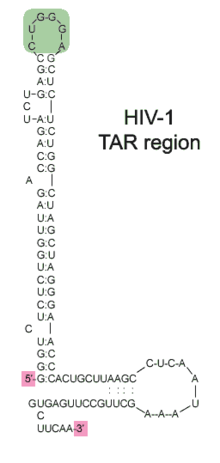Trans-activation response element
- Trans-activation response element
-
Das Trans-activation response element ist ein Teil des genetischen Codes von HI-Viren.

Sequenz der TAR-Region. Die Ansicht zeigt die TAR RNA-Sequenz des HIV-1 Virus. Komplementäre
Basenpaare werden durch einen Doppelpunkt dargestellt. Das 5' und das 3' Ende sind rot hervorgehoben. Die Region, die von dem Tat Protein erkannt wird, ist grün dargestellt.
Das TAR-Element hat zwei Funktionen. Zum einen dient es als Erkennungs-Region für das virale Tat-Protein, das die Übersetzung der Virusbausteine reguliert [1]. Zum anderen dient es als Vorläufer von Mikro-RNA, die Einfluss auf die Regulation der Wirtsproteine nimmt. Vor allen Dingen wird die Apoptose der befallenen Zellen gehemmt [2].
Einzelnachweise
- ↑ Dominique L. Ouellet, Isabelle Plante, Patricia Landry, Corinne Barat, Marie-Ève Janelle, Louis Flamand, Michel J. Tremblay, Patrick Provost: Identification of functional microRNAs released through asymmetrical processing of HIV-1 TAR element. In: Nucleic Acids Research. 36, Nr. 7, 2008, S. 2353-2365, doi:10.1093/nar/gkn076.
- ↑ Zachary Klase, Rafael Winograd, Jeremiah Davis, Lawrence Carpio, Richard Hildreth, Mohammad Heydarian, Sidney Fu, Timothy McCaffrey, Eti Meiri, Mila Ayash-Rashkovsky, Shlomit Gilad, Zwi Bentwich, Fatah Kashanchi: HIV-1 TAR miRNA protects against apoptosis by altering cellular gene expression. In: Retrovirology. 6, Nr. 18, 2009, doi:10.1186/1742-4690-6-18.
Weblinks
Wikimedia Foundation.
Schlagen Sie auch in anderen Wörterbüchern nach:
Trans-activation response element (TAR) — The HIV trans activation response (TAR) element is an RNA element which is known to be required for the trans activation of the viral promoter and for virus replication. The TAR hairpin acts as a binding site for the Tat protein and this… … Wikipedia
Serum response factor — (c fos serum response element binding transcription factor) PDB rendering based on 1hbx … Wikipedia
Cis-regulatory element — A cis regulatory element or cis element is a region of DNA or RNA that regulates the expression of genes located on that same molecule of DNA (often a chromosome). This term is constructed from the Latin word cis, which means on the same side as … Wikipedia
Tar (Begriffsklärung) — Tar bezeichnet: tar, ein Archivformat und Archivierungsprogramm Teer in der englischen Sprache Tar (Ungarn), eine Gemeinde im Komitat Nógrád Tar (Musikinstrument), eine orientalische Laute Tar (Trommel), eine orientalische Trommel Tar (Band),… … Deutsch Wikipedia
TARBP2 — Tar (HIV 1) RNA binding protein 2, also known as TARBP2, is a human gene.cite web | title = Entrez Gene: TARBP2 Tar (HIV 1) RNA binding protein 2| url = http://www.ncbi.nlm.nih.gov/sites/entrez?Db=gene Cmd=ShowDetailView TermToSearch=6895|… … Wikipedia
CREB-binding protein — See also: p300 CBP coactivator family CREB binding protein PDB rendering based on 1f81 … Wikipedia
NFE2L2 — Nuclear factor (erythroid derived 2) like 2 Identifiers Symbols NFE2L2; NRF2 External IDs … Wikipedia
Long-term potentiation — (LTP) is a persistent increase in synaptic strength following high frequency stimulation of a chemical synapse. Studies of LTP are often carried out in slices of the hippocampus, an important organ for learning and memory. In such studies,… … Wikipedia
Calcitriol receptor — Vitamin D (1,25 dihydroxyvitamin D3) receptor PDB rendering based on 1kb2 … Wikipedia
Transcription factor — In the field of molecular biology, a transcription factor (sometimes called a sequence specific DNA binding factor) is a protein that binds to specific sequences of DNA and thereby controls the transfer (or transcription) of genetic information… … Wikipedia
 Sequenz der TAR-Region. Die Ansicht zeigt die TAR RNA-Sequenz des HIV-1 Virus. Komplementäre Basenpaare werden durch einen Doppelpunkt dargestellt. Das 5' und das 3' Ende sind rot hervorgehoben. Die Region, die von dem Tat Protein erkannt wird, ist grün dargestellt.
Sequenz der TAR-Region. Die Ansicht zeigt die TAR RNA-Sequenz des HIV-1 Virus. Komplementäre Basenpaare werden durch einen Doppelpunkt dargestellt. Das 5' und das 3' Ende sind rot hervorgehoben. Die Region, die von dem Tat Protein erkannt wird, ist grün dargestellt.
